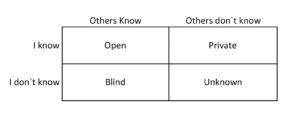Special Edition: This article was written in partnership with the co-author Gillian Dyck. Check-out her Bio in the Contributors page.
In Healthcare, and of course other sectors as well, the nature of professional relationships and our ability to foster them, can greatly affect the efficacy of individuals and the teams that they work with.
Exercises in self-reflection both support and enhance a professional’s ability to understand themselves, and therefore better understand the nature of their connections with others.
An interesting reflective tool – The Johari Window, explains in a very elegant way, the different layers of the self. That which we show others, that which only we know, that which only others know and we are not aware of, and finally that which nobody – neither we, nor others know of us. These four dimensions are organized into a two-by-two matrix, of sorts – as shown below.
Imagine that they are four equal rooms in a house. Each room has a window. You, yourself stand on one of the four sides. Those around you – others – are standing on the side that is just around the corner from you.
From your two vantage points, you are both able to see into one of the four rooms – this is the part of you that you know and you show to others. Each of you have the ability to see into one other room each – you see into a room that represents that which you know of yourself, but you do not share or show to others. The other person also sees into a room that you cannot see – this represents that which others observe or know about you, but that you are unable to see, or are unaware of.
Finally, there is one room that remains that neither of you are able to see – this represents that which nobody knows about you – not even yourself.
There is extensive literature on the topic, so for the purposes of this post, we will focus on the configuration of the diagram, to enhance understanding of the tool and in turn to encourage you, our readers, to enhance your reflection.
If we draw the quadrants of Johari window from our relationships with the groups with which we work most productively, we have what is called the ideal configuration. Imagine that the “room” that both ourselves and others can see into is much larger than the other quadrants. This demonstrates, honesty, transparency, openness, sincerity in our relationships. Also, in the ideal configuration our blind spot is small, demonstrating that communication occurs in both directions and we actively ask for feedback.
The challenge is that we live busy lives and many times we keep these windows scaled in other ways and we do not allow our colleagues to know us better and we do not strive to know their perceptions about us. Often, we are unaware of what we show or don’t show to others – without reflection or discussion with them, it is easy to miss or perhaps even ignore.
Knowledge is liberating. As we open our Johari windows through reflection and discussion, we are able to build on positive relationships, enhance the functioning of our teams, and interact more productively in our communities.
Dear readers, can you identify how your Johari windows are proportioned, and perhaps, what each quadrant might contain for yourself, your friends, and colleagues?



I love Johari Window and i have introduced it with the team in Karachi. The exercise was a true success. The staff did it for their own as well for the one of their colleagues.
I did it for me and was surprised by the results. I realized that I was not as open as I thought.
I requested my wife and my best friend to do it for me and they came out with exact same results. Though one leaves in Nairobi and one in Amman. I am not sure how to read these results….
I encourage the use of Johari Window and the discussions on the results. This is where the magic operates.
Best to all and thanks a million